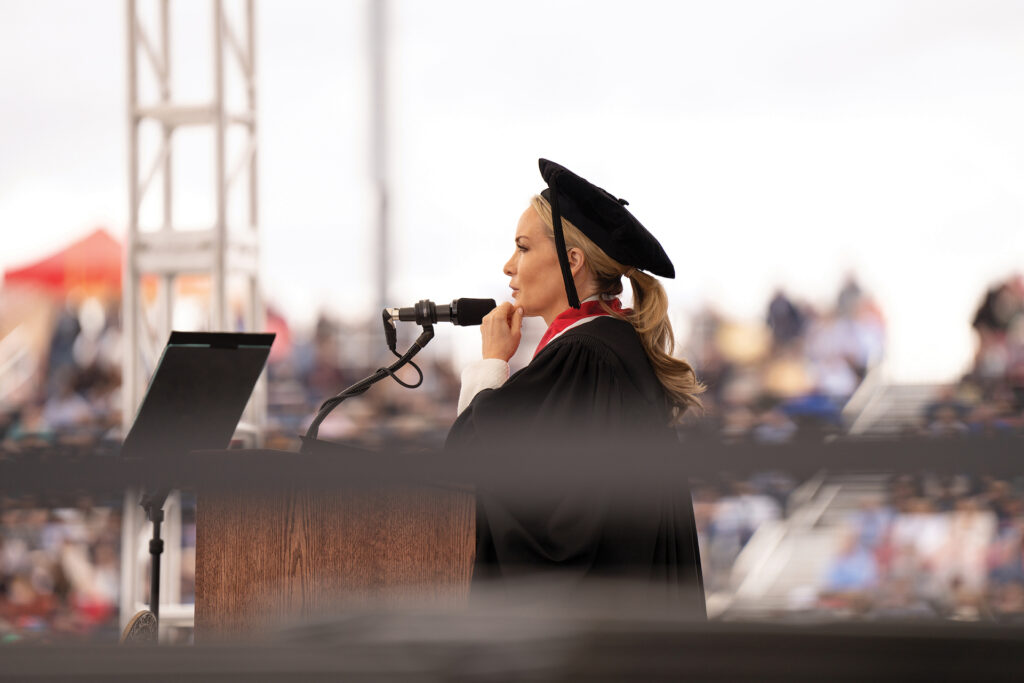
DEMOCRACY ON CAMPUS
Teaching, learning, and experiencing our nation’s core principles
By Anthony Lane | Jan. 3, 2024
Dana Perino’s commencement speech at CSU Pueblo last spring was expertly balanced. Speaking at her alma mater, the Fox News anchor wrapped life lessons in humor and deployed anecdotes with precision. The former communications major and speech team member was humble, even as she sketched the path that led her to the height of American democracy, including service as White House press secretary, the second woman ever to hold that role.
Completing a degree is “a big deal” and “one of life’s great milestones,” Perino told graduates. She gave a nod to how things have changed in the 29 years since she reached that point: “Capture this moment in your heart, as well as Instagram.” Her take-home advice was simple and powerful: “You are American, you are loved, you are educated, and you get to make decisions, so you are in the driver’s seat.”
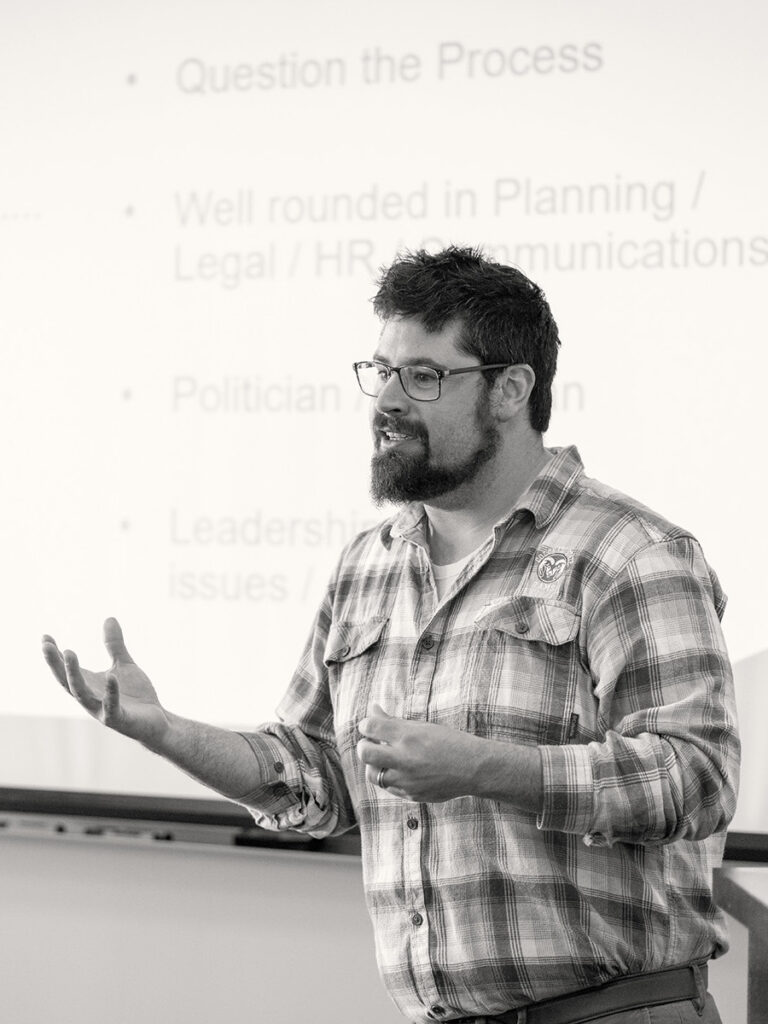
Students are passionate about the future and also about coming up with collaborative policy solutions”
— Sam Houghteling, program manager, CSU’s Straayer Center for Public Service Leadership
Sam Houghteling, program manager for CSU’s Straayer Center for Public Service Leadership, teaches students fundamentals of American democracy. The center is a key university asset, educating students about democracy and civic engagement. Photo: Joe A. Mendoza / Colorado State University.
Equipping students to thrive as citizens and participate in democracy is at the heart of what colleges do. The essential skills and the capacities to learn, evaluate arguments, and marshal evidence are desirable outcomes across institutions and academic disciplines. Perino’s ascent reflects an American ideal – where education aligns with hard work to unleash talent and propel success.
Yet, Perino spoke to graduates at a time of mounting unease about the state of our democracy and the future of elections. The 2020 presidential contest was defined by rancor, distrust, and a riot at the U.S. Capitol. Now, 2024 is shaping up as a likely rematch.
As candidates and commentators across the spectrum have noted, we live in a time of yawning political divides, perilously close elections, and dizzying technological advancement. The media landscape has shifted from broad to narrow, pushing audiences into echo chambers where bass notes stir the lines between the social and antisocial, the meme-worthy and the cruel. And artificial intelligence is emerging as a tool with no apparent mechanism to stem a flood of information that is mainstreaming deception, submerging truth, and eroding our collective sense that it’s possible to tell the difference.
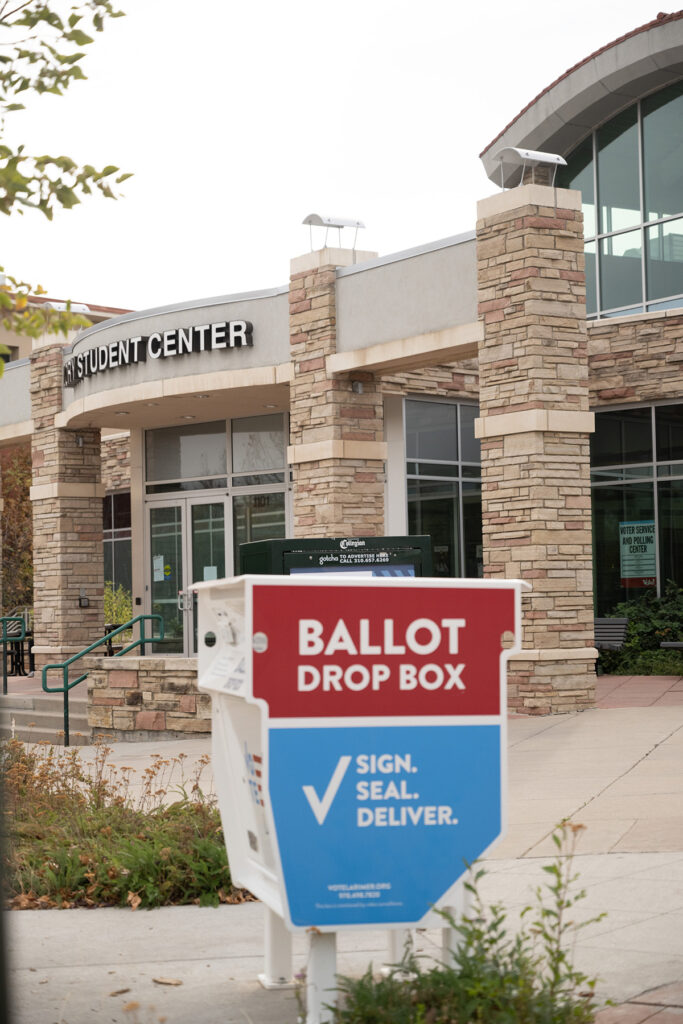
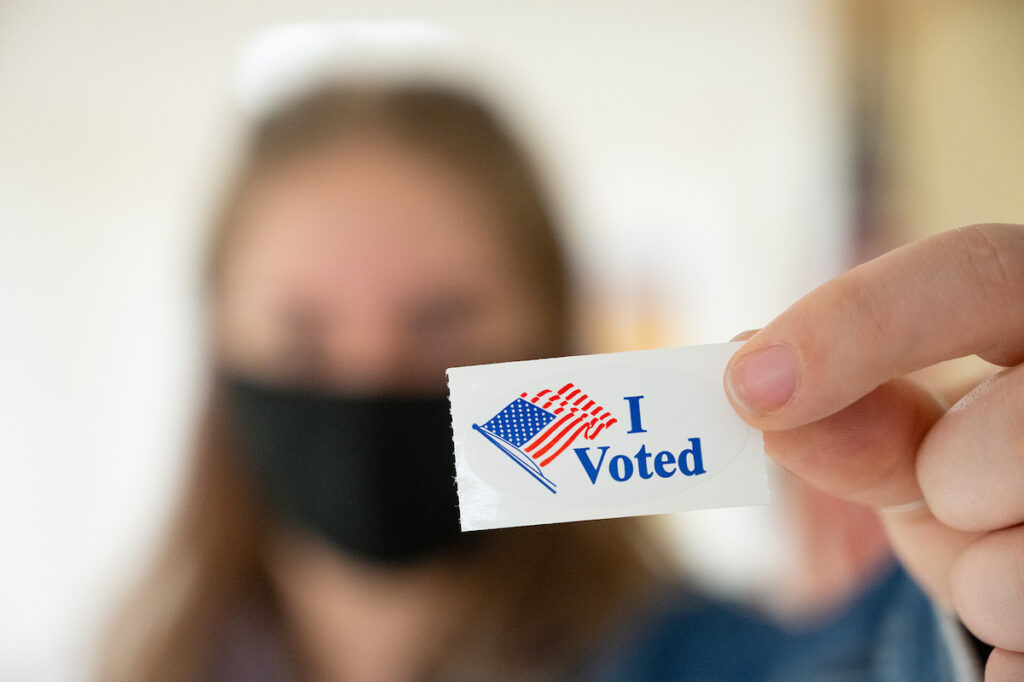
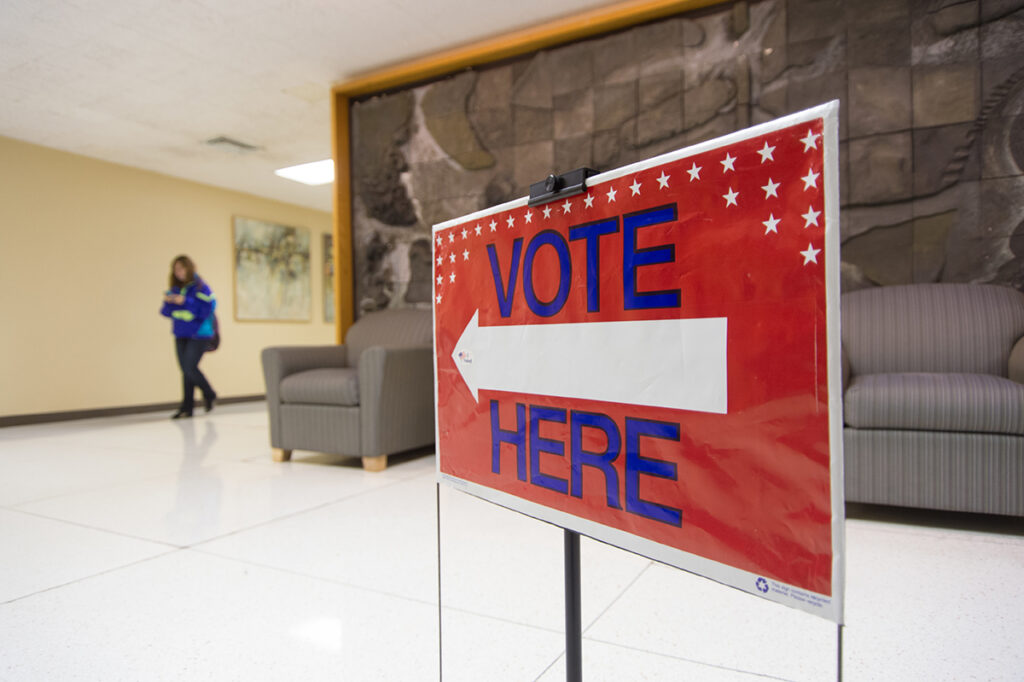
Colorado State University is a national leader in student voting. The CSU Lory Student Center hosts in-person voting during elections, and ballot drop-off boxes are an easy way for CSU students to cast their votes during elections. Photography: Colorado State University.
For CSU System campuses and others, a central question is: How should democracy be taught, learned, and experienced so that academics meet the challenges of our times? At Colorado State University in Fort Collins and at CSU Pueblo, the response involves a doubling down on the institutions’ core academic functions, a deepening of formal and informal activities centered on leadership and engagement, and a reaching out across and beyond each community.
Ben Withers, dean of CSU’s College of Liberal Arts, recalled the moment when it became clear such efforts were needed – just after the 2016 presidential election, when the outcome surprised many pollsters by eluding predictions. Withers had recently arrived in Fort Collins to start as dean, and that sense of surprise gave new definition to his role.
“There were questions about how we were making sure that we were having inclusive conversations in our classrooms and beyond,” Withers said. “The sense of polarization that we started to feel in 2016, and even before, has just increased the idea that people are self-sorting, and there’s sometimes difficulty, off campus and on, having conversations across differences.”
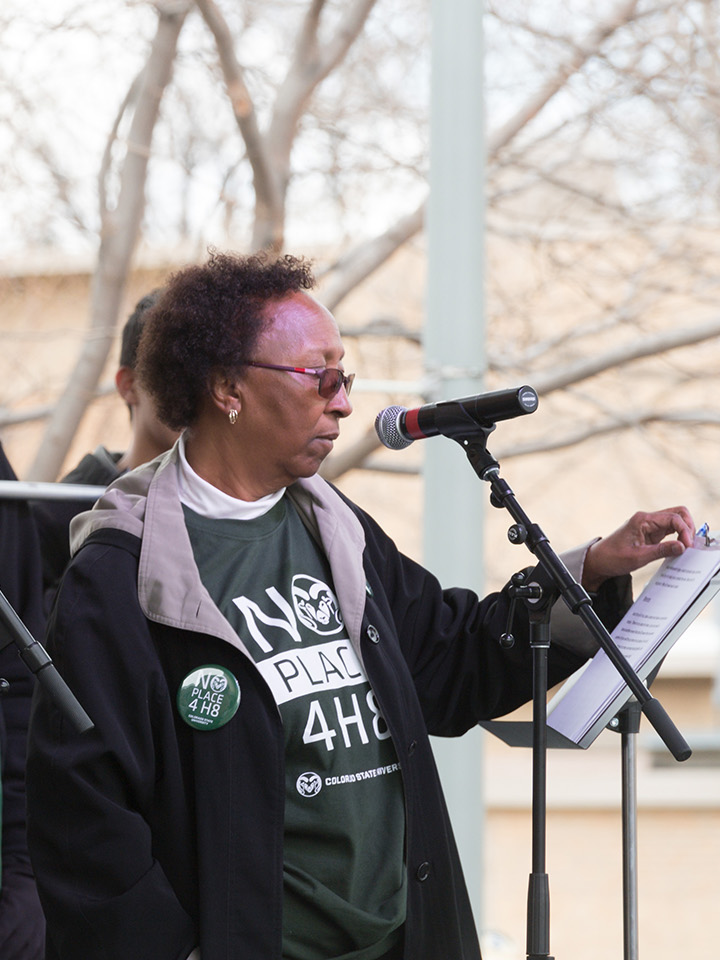
Blanche Hughes, CSU vice president for student affairs, speaks at CSUnite. Photo: Colorado State University.
THOSE QUESTIONS TRIGGERED a review within the College of Liberal Arts. The assessment focused on the breadth of courses offered and the content within them; it included how faculty can approach difficult topics to be sure students can share their perspectives – and listen to the perspectives of those with whom they disagree.
This year, that work blossomed into a campuswide year of thematic programming called Democracy and Civic Engagement. The special programming is designed to build understanding and establish connections during a presidential election year. Withers and Marissa Dienstag, a Presidential Leadership fellow who oversees thematic year programming, convened a group of more than 30 campus leaders from across colleges and divisions to talk about activities and issues and to discuss ideas for collaboration.
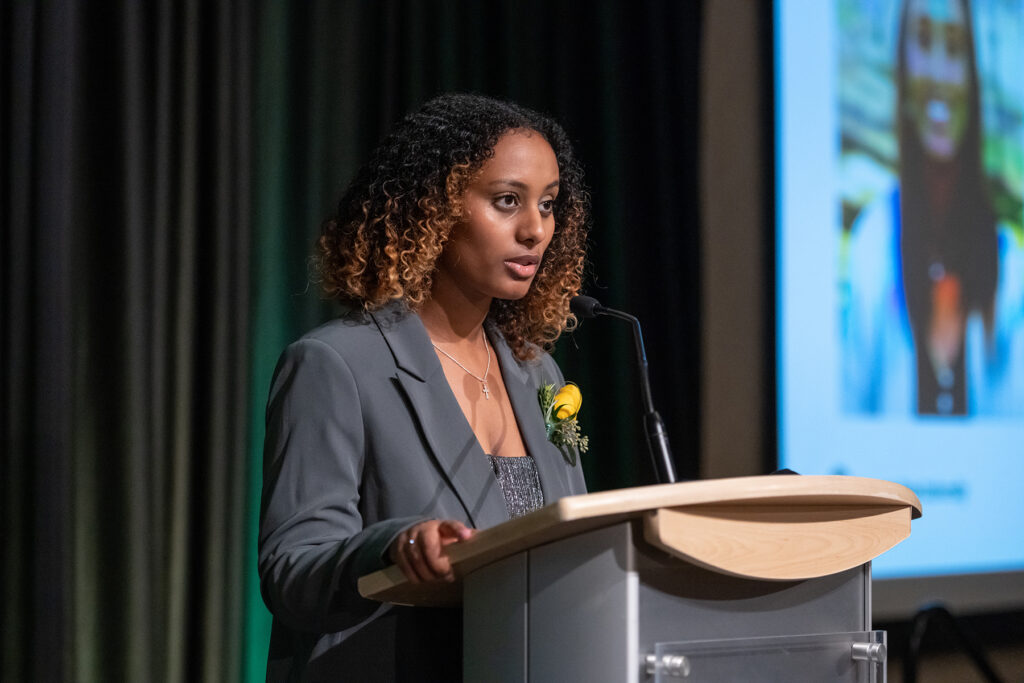
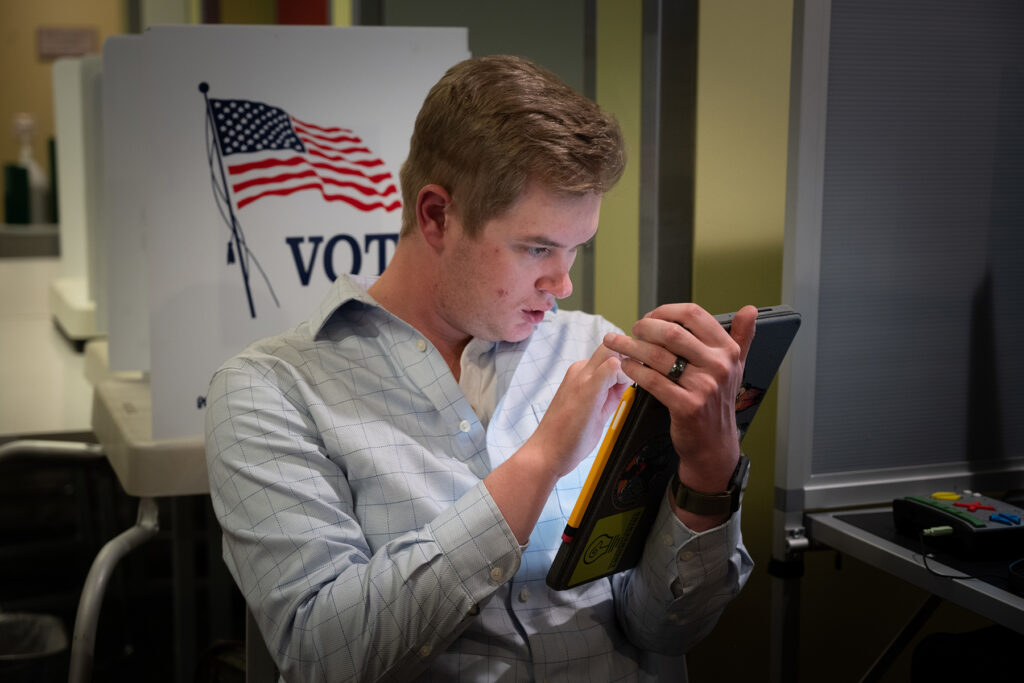
Left: Merry Gebretsadik, a CSU alumna who works in the Colorado Office of the Governor, speaks to first-generation scholars on campus. Right: Robert Lamm represents CSU as a Presidential Ambassador. Photography: Colorado State University.
Top: Merry Gebretsadik, a CSU alumna who works in the Colorado Office of the Governor, speaks to first-generation scholars on campus. Bottom: Robert Lamm represents CSU as a Presidential Ambassador. Photography: Colorado State University.
The calendar of democracy-related programming includes a wide range of activities designed to deepen learning around democratic principles. These events have included political discussions moderated by CSU President Amy Parsons, invited lectures, dinner talks, film screenings, an art show, and presentations that connect democracy to professional disciplines in unexpected ways, such as a panel discussion about energy justice hosted by the Walter Scott, Jr. College of Engineering.
Months into the thematic year, Withers expressed hope about the direction of campus conversations. He also acknowledged the need for flexibility and vigilance in adapting to both societal changes and the shifting needs of students. The idea of requiring all students to take a civics-focused course, or perhaps a course centered more broadly on the skills of citizenship, might be worthy of discussion, Withers said. Yet, he also sees value in CSU’s current approach of allowing undergraduates to pick courses in different disciplines to meet curriculum requirements and to “have more agency” in charting their educations.

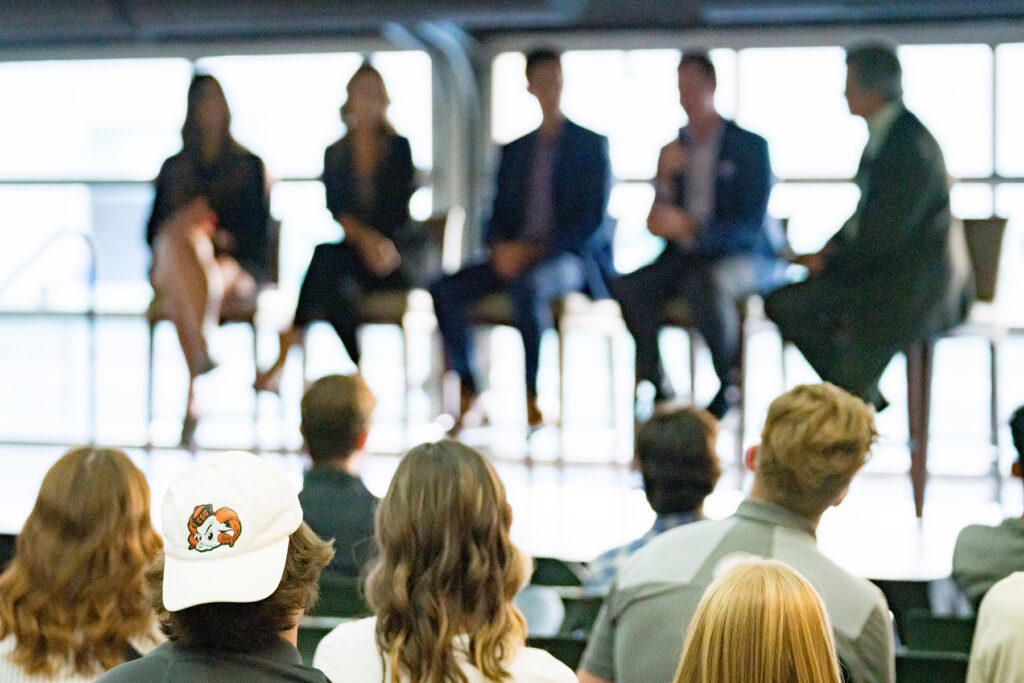
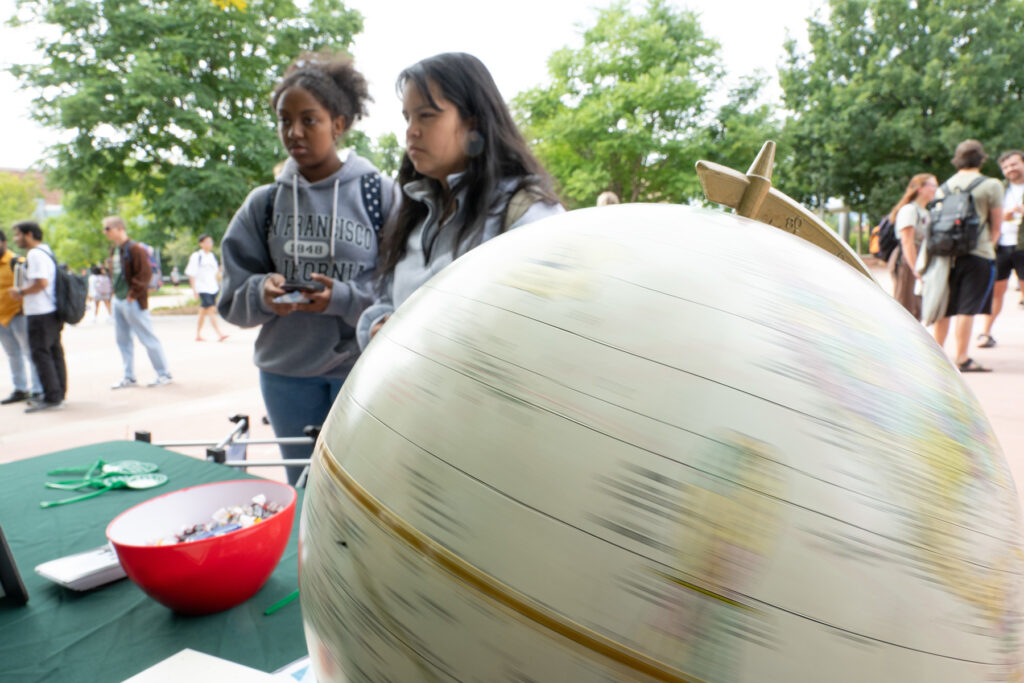
CSU’s year of Democracy and Civic Engagement features a range of discussions and events, including a kickoff event hosted by the CSU Center for Public Deliberation. Photography: Colorado State University.
The national backdrop for this work tends toward gloom and worry, including a spate of recent books examining trends in the United States and around the globe, and coming away with insights on how democracies “die” or “fall apart,” or announcing that democracy is “in peril” or in its “twilight.”
Withers takes a different view. “You know, there are some very impactful social, cultural, and economic changes that we’re trying to address, and we’re trying to address them in a multicultural, multiethnic democracy,” he said.
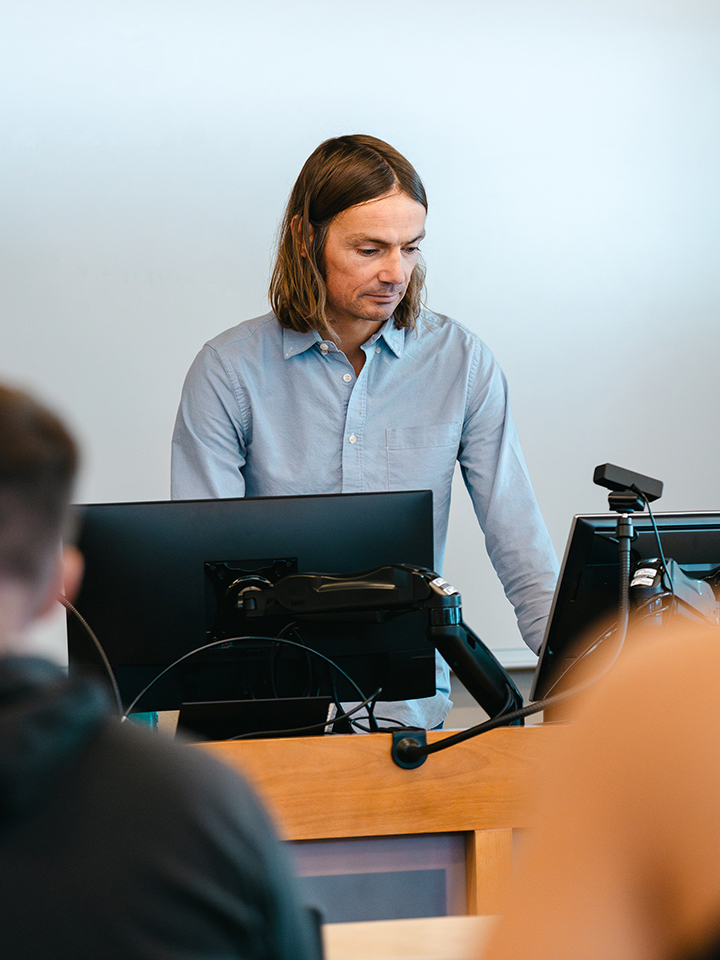
I feel like we do democracy every day – that's part of a liberal arts education.”
— Ryan Strickler, associate professor of political science, CSU Pueblo
Ryan Strickler, an associate professor of political science at CSU Pueblo, teaches a class called Media, Politics, and Power. Photo: Jerod Young / CSU Pueblo.
Across academic disciplines and CSU’s campuses in Pueblo and Fort Collins, students and faculty routinely wrestle with these and related issues. For instance, Moti Gorin, an associate professor of philosophy, recently teed up a discussion in his 400-level Democracy and Free Speech course by talking about “the Stump,” which sits outside the Lory Student Center and symbolizes the campus’s commitment to free speech. At the Stump and elsewhere on campus, the university protects the First Amendment rights of individuals to speak freely and assemble in groups.
Academic freedom is different, Gorin continued, offering certain protections and creating obligations for students and faculty, and also generating certain tensions. Classrooms, for instance, are learning spaces in which students can take “reasoned exception” to the views of their instructors or peers; yet, they are not public spaces, meaning the megaphone that rallied a crowd out at the Stump isn’t an accepted means of building one’s case in a classroom discussion.
Alongside freedom of speech and academic freedom are gray areas of taste and tact shading toward threats and the risk of harm. Gorin mentioned the controversy around a speech last March at Stanford University law school that devolved into a shouting match after protesters in the audience refused to back down. Unlike free speech, use of the “heckler’s veto” is not protected, Gorin said.
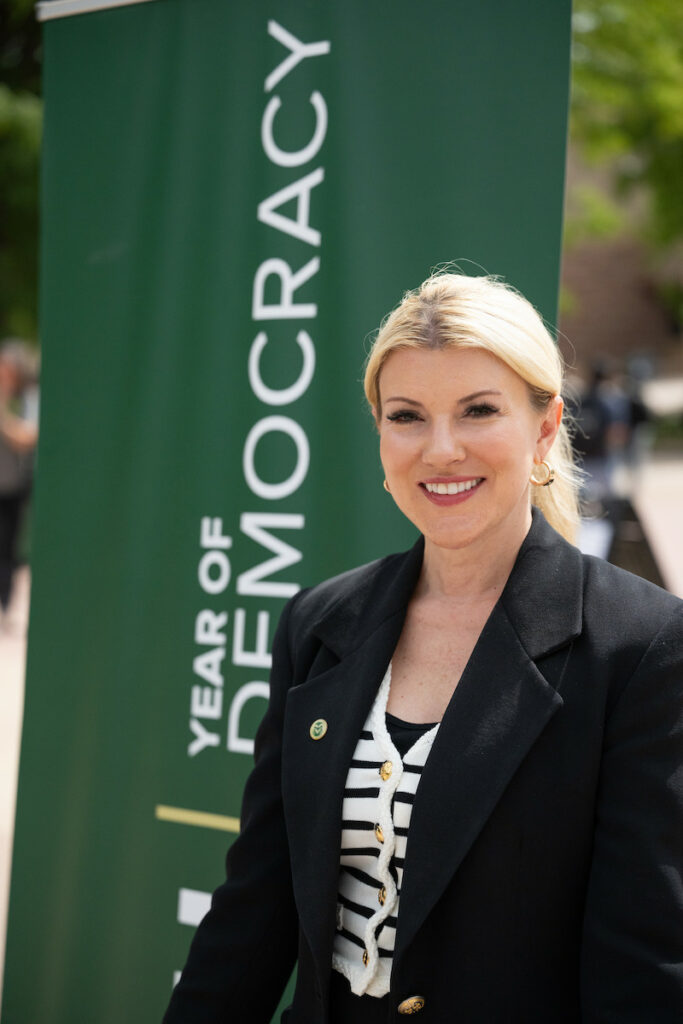
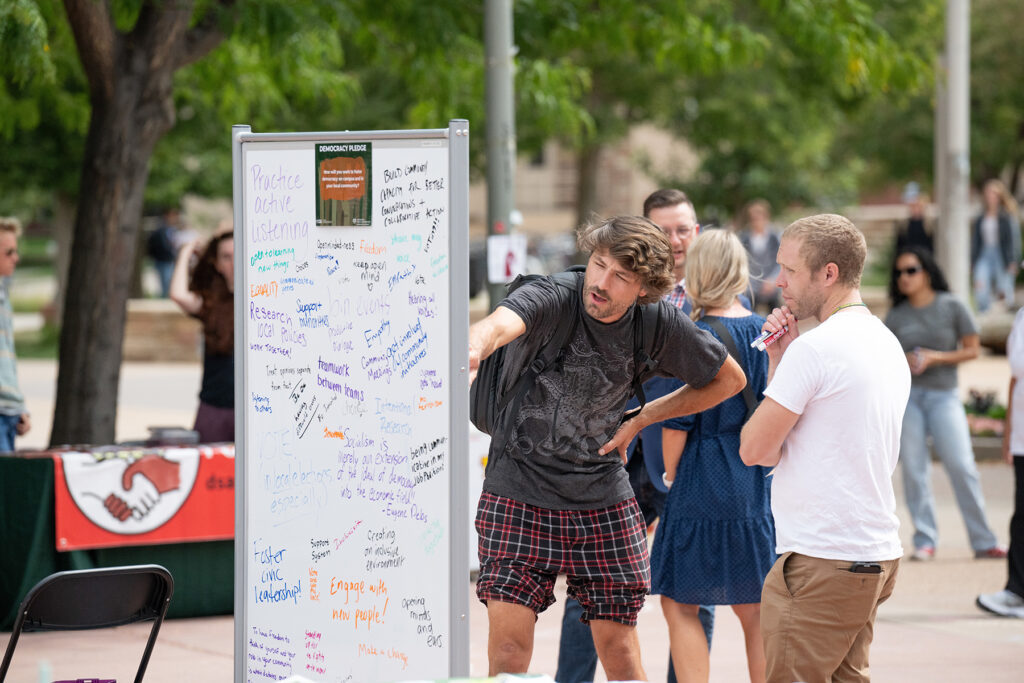

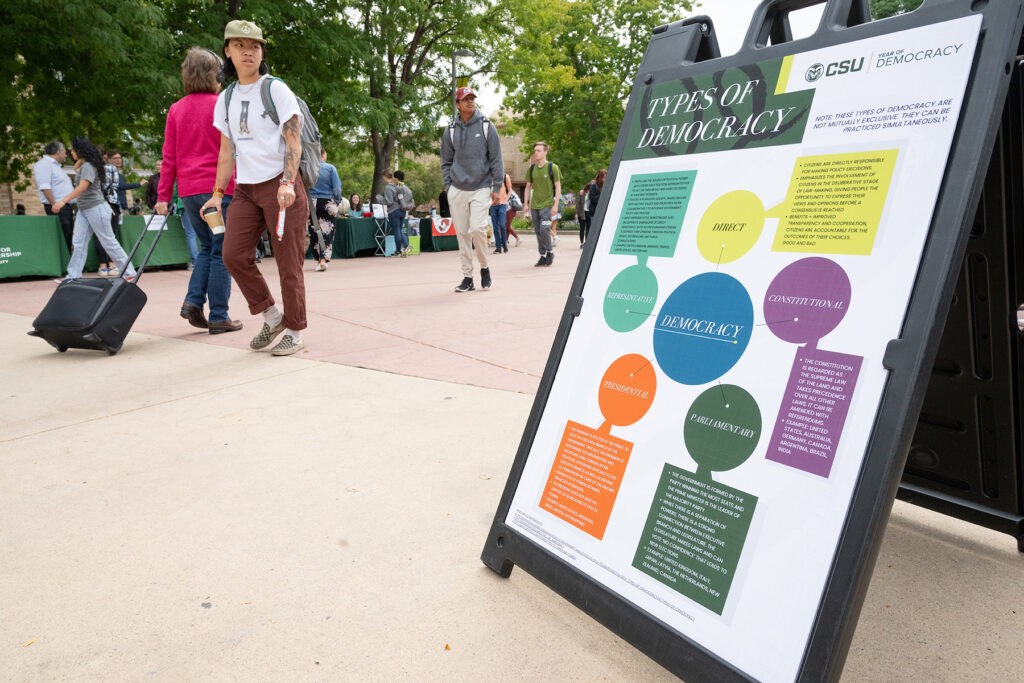
Clockwise from left: CSU President Amy Parsons hopes CSU will become a national leader in teaching students about democracy and civic engagement. / CSU students jot down notes about key principles of democracy during an event on campus. / A student promotes the year of Democracy and Civic Engagement at CSU. / A sign on the Plaza notes that democracy takes several forms. Photography: Colorado State University.
From top: CSU President Amy Parsons hopes CSU will become a national leader in teaching students about democracy and civic engagement. / CSU students jot down notes about key principles of democracy during an event on campus. / A student promotes the year of Democracy and Civic Engagement at CSU. / A sign on the Plaza notes that democracy takes several forms. Photography: Colorado State University.
Over in Daniel Weitzel’s Empirical Analysis of Democracy class – another course designed for the thematic year – political science students explored a different set of questions and discussed approaches and data sources that might be used to develop answers.
“How would diversity negatively impact democracy?” Weitzel asked. Perhaps it carves out who gets what or creates lines for political conflict, he proposed. Then he switched tack. “Can it help democracy?” he asked.
“Maybe it can make people more tolerant?” one student ventured.
Weitzel whizzed through a series of slides that kept the waters muddy. For a series of countries, he plotted a line reflecting an index of democratic health and another line tracing diversity, both over the past 70 years. Denmark, with low diversity creeping upward, showed consistently high marks for democracy over the entire period. Hungary, measuring just slightly more diverse, leapt from low to high democracy in the late ’80s, and then abruptly changed course, with the election of a new prime minister, toward a more limited democracy. Peru, moderately diverse, swung back and forth on the democracy scale, while South Africa, highly diverse, jumped from low democracy to high when the apartheid system of segregation ended in the early 1990s. For the United States, the plot showed diversity climbing steadily and a high score for democracy, with only a slight drop in the past five years.
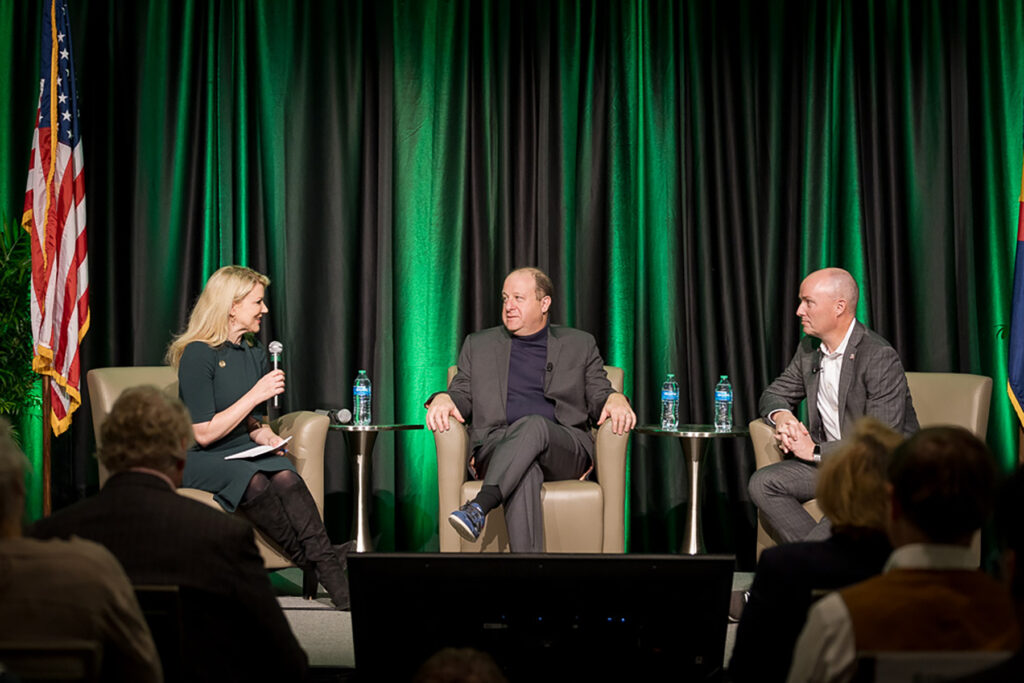
CSU President Amy Parsons leads Colorado Gov. Jared Polis and Utah Gov. Spencer Cox in a discussion about the need for civil discourse in politics and private life. Photo: Colorado State University.
“You had an assault on your democratic institutions, and you survived it,” Weitzel said, referring to the assault on the U.S. Capitol on Jan. 6, 2021. “That’s not something a lot of democracies can say.” Later, Weitzel, an assistant professor of political science, explained how his perspective, that of a German academic who studies democracies, can be a benefit when discussions touch on the vulnerability of American democracy.
Numbers and graphs may tell a partial story about the health of American democracy. For Camille Dungy, a University Distinguished Professor of English, that health is also reflected in language and relationships. She ran one session of her course, Contemporary Poets and the Shaping of American Democracy, as a sort of exercise in democracy, turning the discussion over to one student to comment on the day’s readings and the lecture notes, who then called on another to carry the thread.
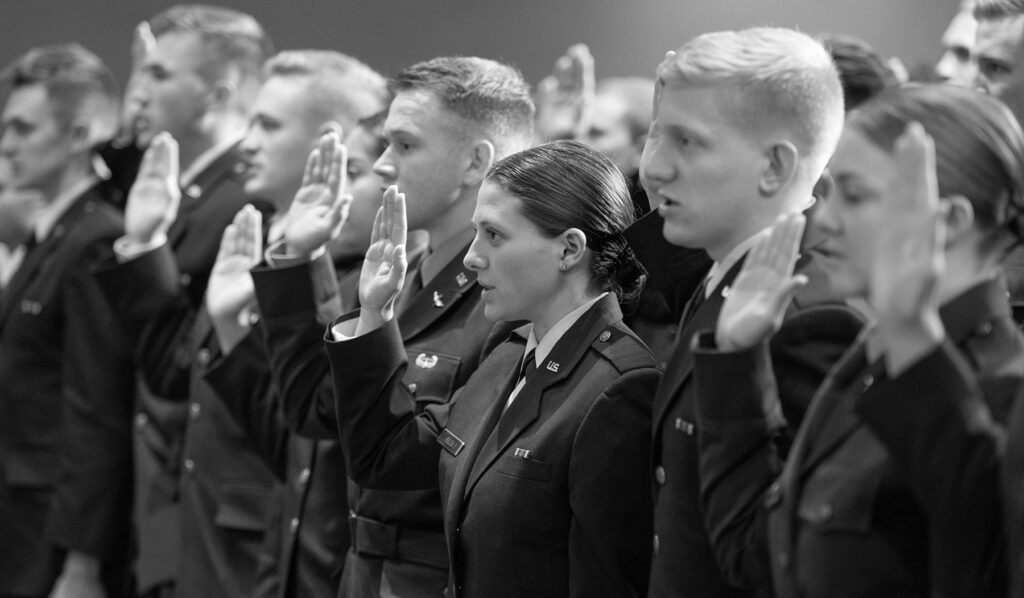
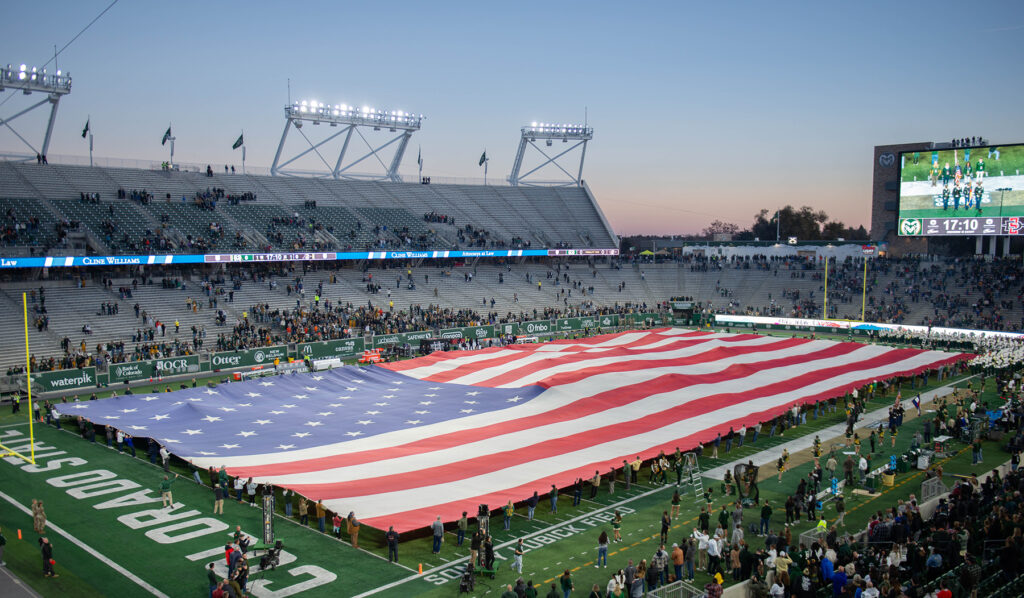
Left: Military officer training is part of Colorado State’s land-grant mission. Right: A U.S. flag is unfurled at Canvas Stadium prior to a CSU football game. Photography: Colorado State University.
Top: Military officer training is part of Colorado State’s land-grant mission. Bottom: A U.S. flag is unfurled at Canvas Stadium prior to a CSU football game. Photography: Colorado State University.
THE CONVERSATION TURNED to “Nature Poem,” by Tommy Pico, a Native American poet who grew up on the Viejas Reservation, near San Diego. One student said Pico’s condensed writing style reminded her of what appears on the social media site Twitter, now known as X. “Twitter is so politically charged,” she said. “Every time I go on there, I get scared.”
In other class sessions, Dungy said, she and her students have spent long periods talking about terms, including what it means to be “political” and what defines “the West.” Students, she said, have increasingly diverse cultural experiences. “As ‘We the People’ has expanded, we have to keep asking, ‘Now, who are we?’” Dungy said. “Higher education is equipped for that. I think my job as a professor is to help students think and learn about what they think and why.”
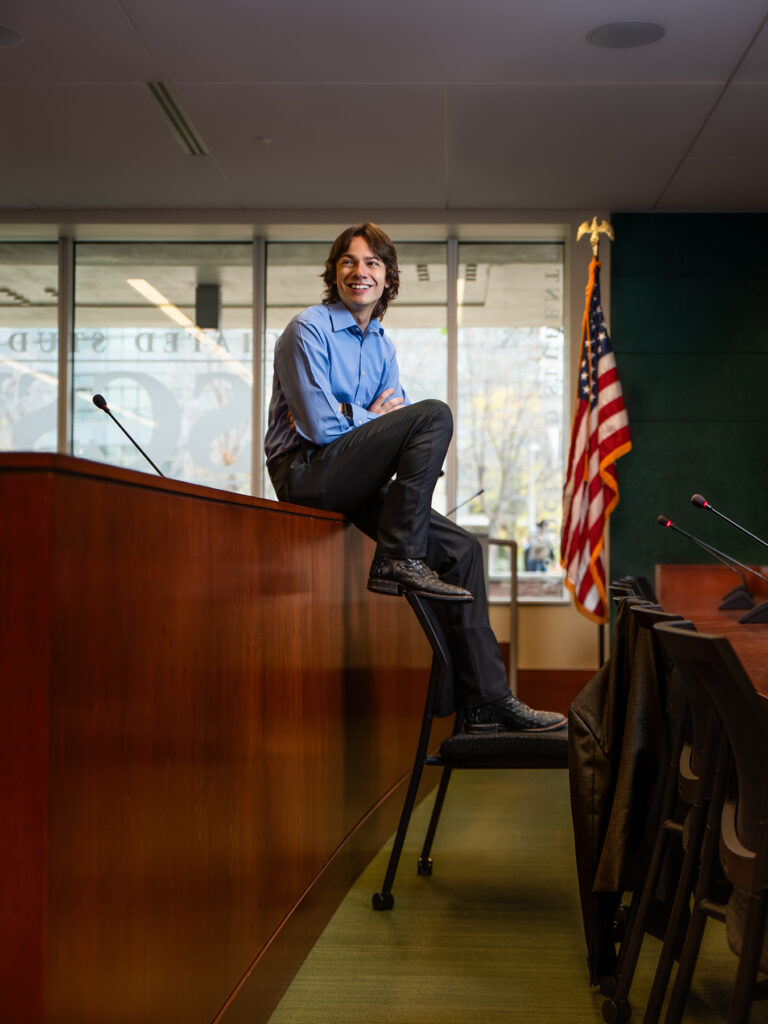
Nick DeSalvo, shown in chambers of the Associated Students of Colorado State University, is student body president and has worked closely with city of Fort Collins elected leaders on issues of importance to students. Photo: Mary Neiberg.
Encouraging self-awareness is also a goal for Ryan Strickler, an associate professor of political science at CSU Pueblo. “I feel like we do democracy every day – that’s part of a liberal arts education,” he said.
For a session of Strickler’s course on Media, Politics, and Power, students kept journals tracking their weekly consumption of social and news media. One student said he sought out political news, while another observed that his efforts to avoid politics on social media were often unsuccessful: “I feel it would try to, like, piss me off. It wanted me to be political,” he said.
They talked about the potential political biases of different websites and news sources, and Strickler asked students about minimal effects theory, which posits that individual beliefs are more the result of socialization than of media exposure. Yet, there are other distortions, including the tendency for media to hype breaking news and drama over context and nuance. “This is one of the other ways media is conditioning how we think about the world,” Strickler said.
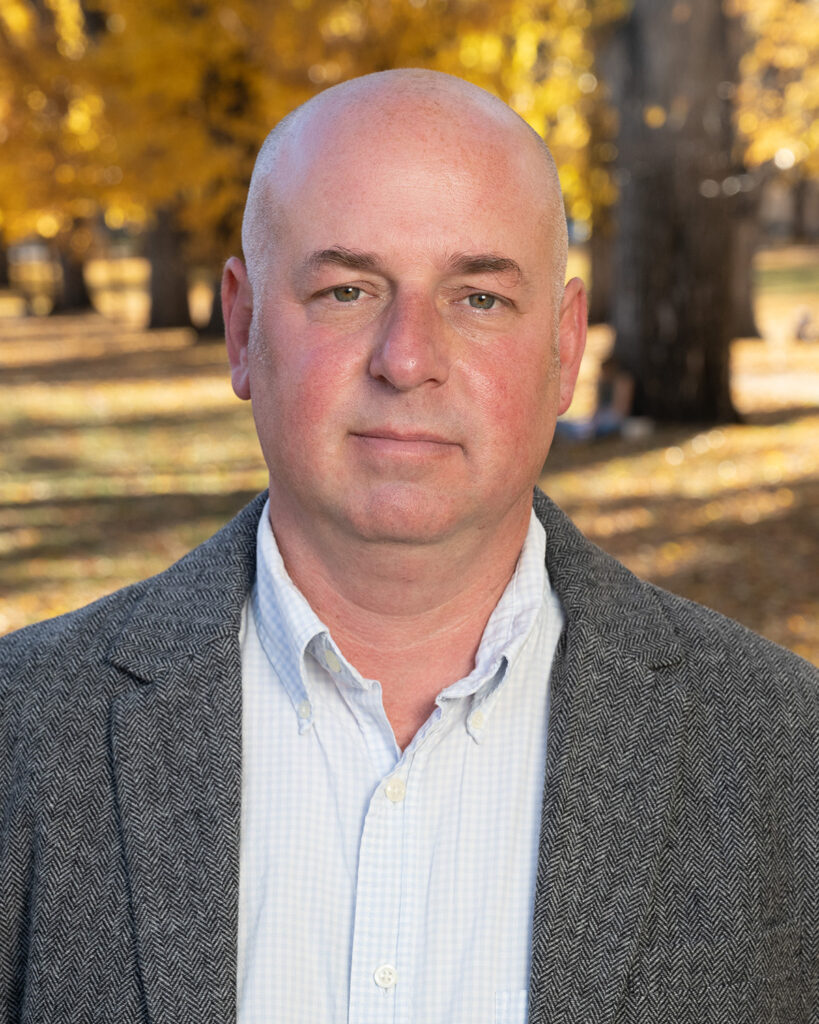
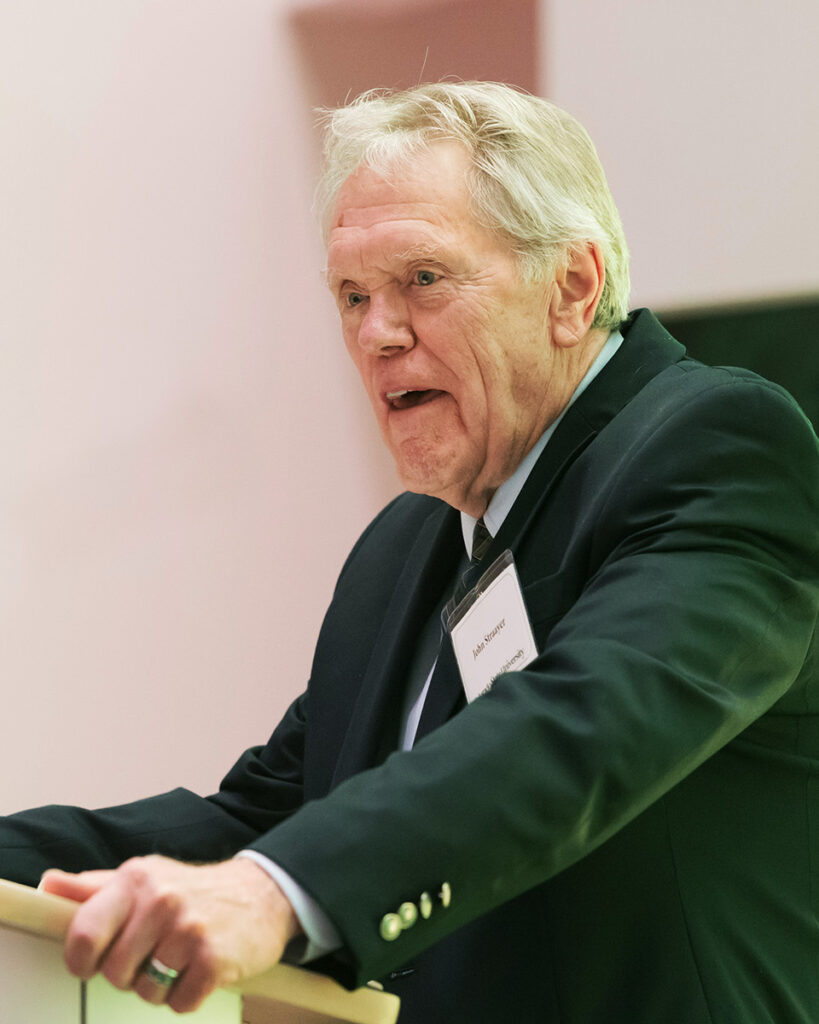
Left: Moti Gorin, an associate professor of philosophy, is among those teaching special courses during the year of Democracy and Civic Engagement. Right: CSU Professor Emeritus John Straayer directed the Legislative Internship Program and led students on trips to the Colorado Capitol during his years teaching political science. Photography: Colorado State University.
Top: Moti Gorin, an associate professor of philosophy, is among those teaching special courses during the year of Democracy and Civic Engagement. Bottom: CSU Professor Emeritus John Straayer directed the Legislative Internship Program and led students on trips to the Colorado Capitol during his years teaching political science. Photography: Colorado State University.
If governance at the national level can seem remote, coarse, and dispiriting, decision-making at the local level can be highly personal, granular, and even offer hope. Last spring, dozens of CSU students got a firsthand civics lesson when they packed a Fort Collins City Council meeting to oppose the city’s long-standing U+2 ordinance, which prohibits more than three unrelated people from sharing a residence. The ordinance is designed to maintain property values and neighborhood peace and quiet, but many students object because fewer occupants in a rental house typically means higher monthly rent.
Mayor Jeni Arndt, opening the public comment period, warmly welcomed everyone to the meeting and reviewed a few rules, including a two-minute time limit for each speaker. “We’re all here for the same purpose, and that’s the future of our community, and we care about it,” she said. She was still smiling more than two hours later as she thanked the 78 speakers who shared their thoughts on U+2 and other issues of concern, from oil and gas regulations to air quality.
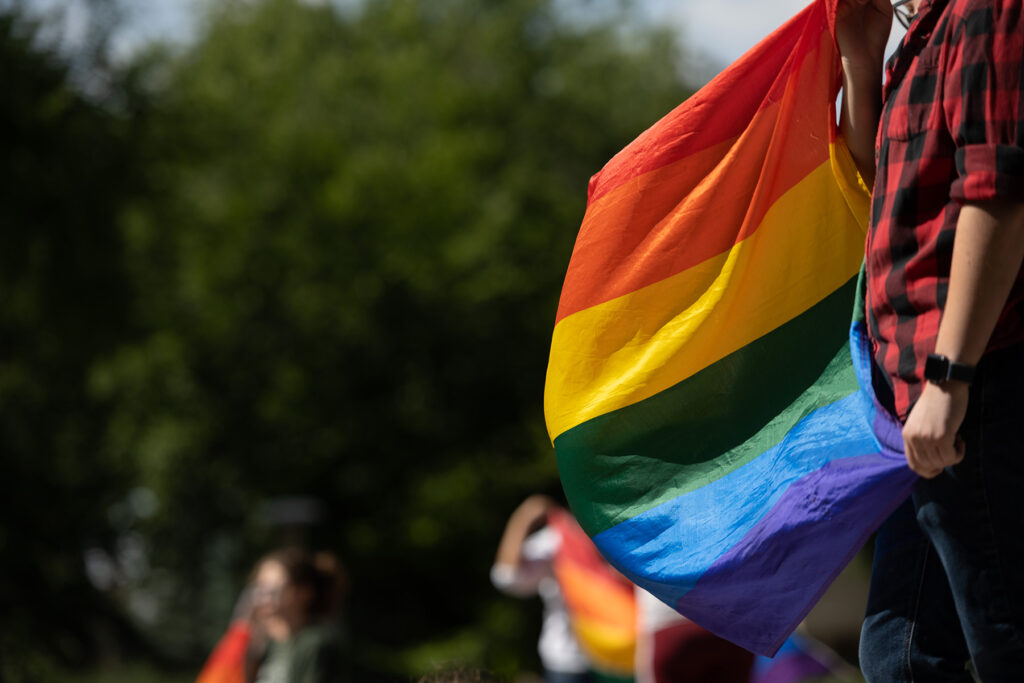
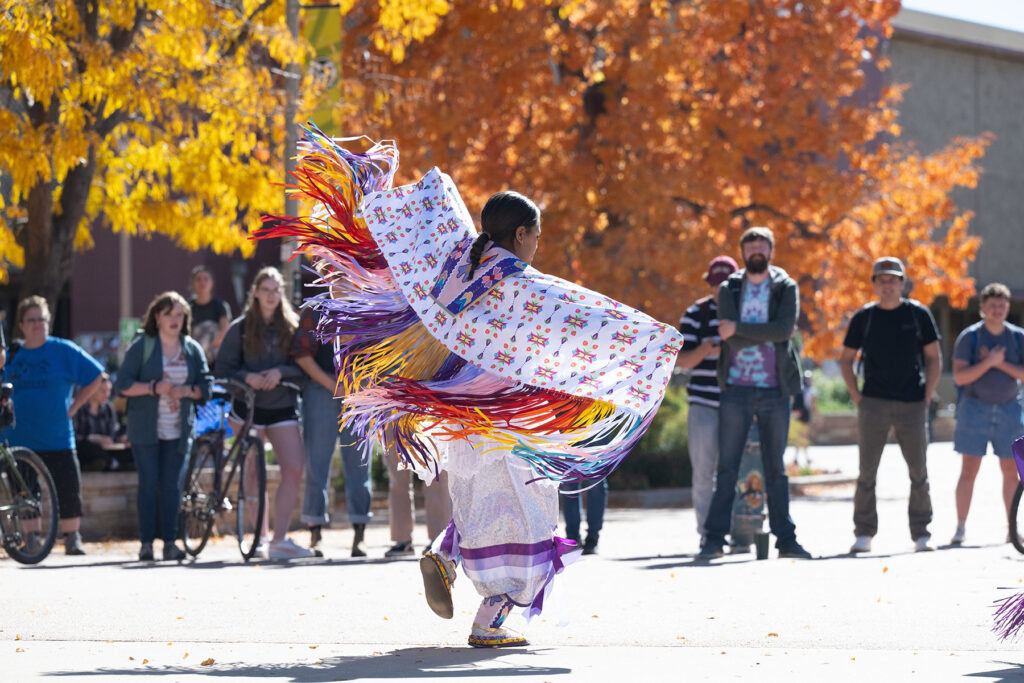
Left: The Pride Resource Center represents LGBTQ+ students at CSU. Right: CSU’s Native American Cultural Center helps represent Native students on campus. Photography: Colorado State University.
Top: The Pride Resource Center represents LGBTQ+ students at CSU. Bottom: CSU’s Native American Cultural Center helps represent Native students on campus. Photography: Colorado State University.
NICK DESALVO, THEN a sophomore and speaker of the Senate for the Associated Students of CSU, was among those who spoke. He had helped organize student turnout that day, and he was a candidate for ASCSU president, having run on a platform that included a push to repeal U+2 to improve affordable housing options. The election concluded the next day, and DeSalvo was victorious.
Now a junior, DeSalvo, a political science major minoring in legal studies, is planning to run for a second term in office so he can keep pushing ahead. “I’m of the view that democracy is about collaboration rather than confrontation,” said DeSalvo, who committed to building connections with city leaders.
Words like that resonate with Mayor Arndt. DeSalvo and others in student government had been reaching out and developing connections with her and with the rest of City Council even before he was elected president. “It’s that personality that’s reaching out, inviting, including, bringing you in, asking you what you think about U+2, working together,” Arndt said. “He and I meet regularly – between the two of us we represent the whole city.”
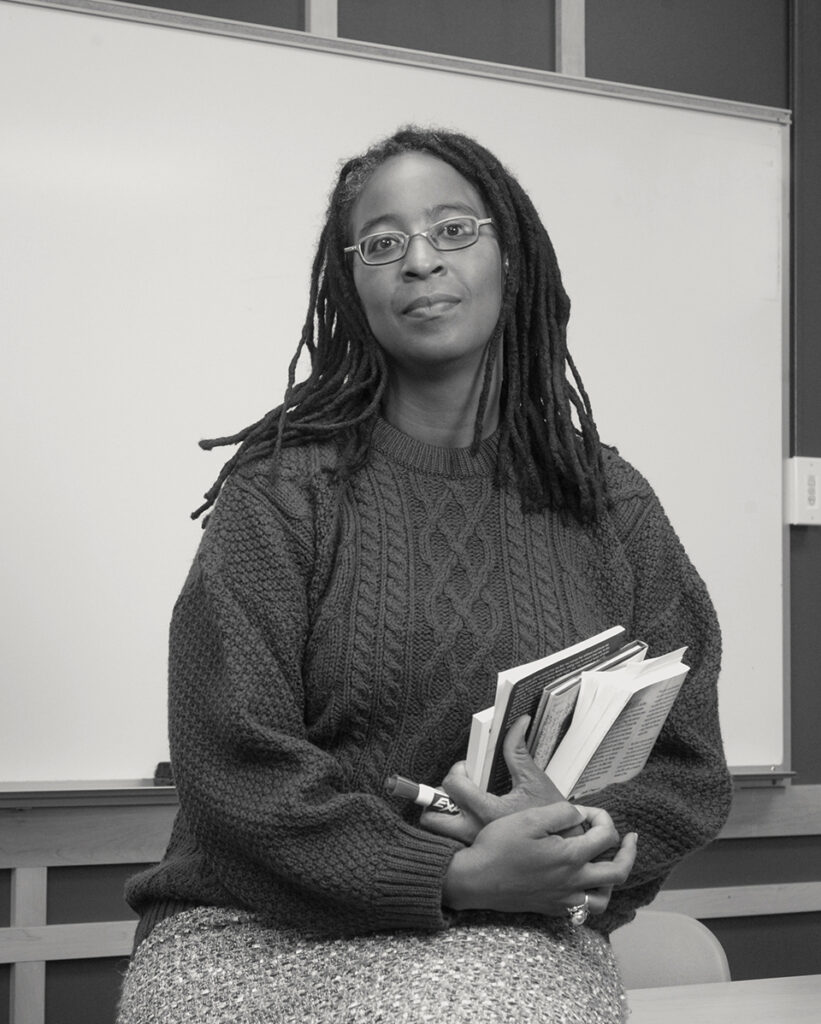
Students have increasingly diverse cultural experiences. As ‘We the People’ has expanded, we have to keep asking, ‘Now, who are we?’ Higher education is equipped for that. I think my job as a professor is to help students think and learn about what they think and why.”
— Camille Dungy, University Distinguished Professor
Camille Dungy, a University Distinguished Professor of English, is a celebrated poet and is among the CSU professors teaching special courses as part of the year of Democracy and Civic Engagement. Photo: John Eisele / Colorado State University.
Such optimism also appears among those working with students and student leaders. Sam Houghteling, program manager for CSU’s Straayer Center for Public Service Leadership, showed up at that spring City Council meeting to speak about housing affordability and to support the students: “They are passionate about the future and also about coming up with collaborative policy solutions,” he said.
The Straayer Center, founded in 2017, supports public service education and activities; it is named for John Straayer, an professor emeritus of political science who directed CSU’s Legislative Internship Program for more than 40 years. That program just celebrated its 50th anniversary. It has more than 1,200 alumni who descended by the vanload on the State Capitol twice each week during the spring semester to learn the ins and outs of lawmaking. Graduates have applied insights from the program to careers in and intersecting with government, from law and education to business. The center also supports the CSU in D.C. program for students seeking a semester-long experience working in a congressional office or with a national nonprofit.
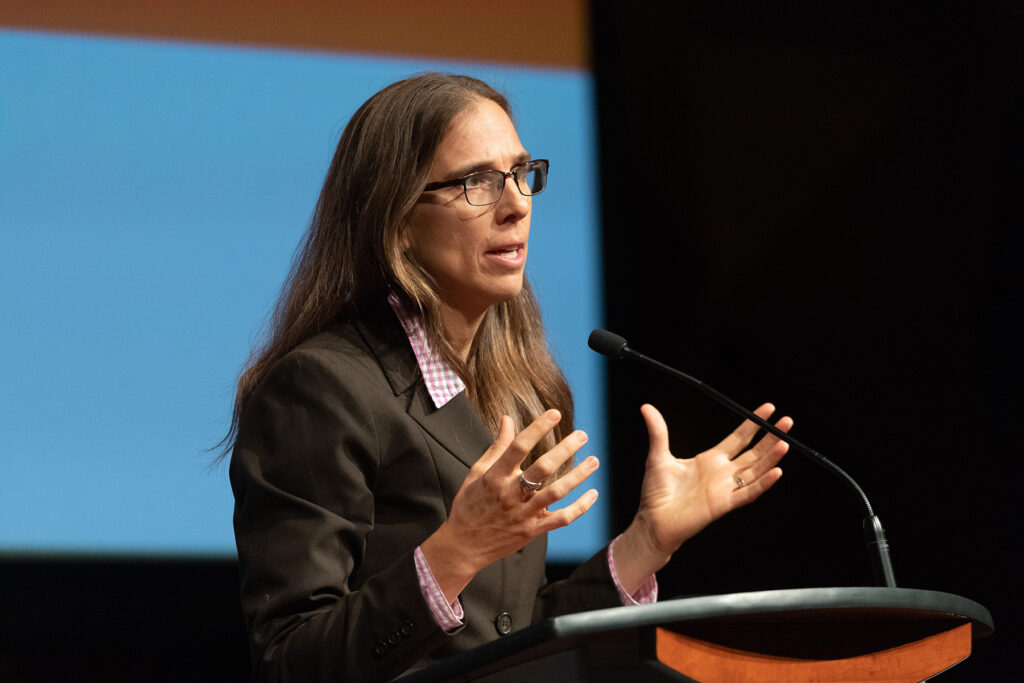
Jen Johnson, director of Student Leadership, Involvement, and Community Engagement, leads CSU programs that encourage students to get involved in civics and community life. Photo: Colorado State University.
On campus, the Student Leadership, Involvement, and Community Engagement office oversees more than 400 student organizations, a range of leadership development options, programs focused on volunteering, relieving food and housing insecurity, and other engagement activities. SLiCE Director Jen Johnson is enthusiastic about CSU students and their activities, not least their participation in elections. According to data from Tufts University’s Institute for Democracy and Higher Education, more than 76 percent of CSU students voted in the 2020 election, and 54 percent voted in 2018, a midterm election, exceeding the national average among college students by a full 15 percentage points.
“I sit with college students every day, and they are awesome,” Johnson said. “They’re engaged, and they talk about issues in a way more intelligent way than I did at that age.” For her part, Johnson believes the pandemic, and the experience of vitriol in a polarized time, has conferred a certain sensitivity and worldliness on the current generation of students.
That sensitivity came across in a conversation with Mikayla Lerch, who served as CSU Pueblo’s student body president leading up to her graduation last May, when she had a commencement speaking role alongside Perino. Lerch now works as CSU Pueblo’s admissions counselor for the Denver region as she considers options for law school, grad school, or possibly government work.

Mikayla Lerch was a student leader during her time at CSU Pueblo and helped represent the CSU System during a trip to the U.S. Capitol. Photo: Jerod Young / CSU Pueblo.
In her graduation remarks, Lerch urged graduates to be gentle with themselves, to maintain perspective, and to have grace as they take their next steps. She was surprised when Perino, while accepting an honorary doctorate, took a moment to recognize Lerch and her service. Afterward, what stood out to Lerch was the human side of the interaction, the sense of possibility. “It was really cool to see how she started at our alma mater, and how she made her way,” Lerch said. “You may have a thought of where you want to be, but life just kind of opens up a bunch of opportunities.”
The idea that education is about opening doors resonates with Marie Humphrey, CSU Pueblo’s vice president for student affairs and dean of students. Growing up in Alabama, the youngest of five children, Humphrey had the support of her family in becoming the first in their circle to earn a college degree. Her father, with an eighth-grade education, recognized the transformative power of education, telling her, “It’s something no one can take away from you.”
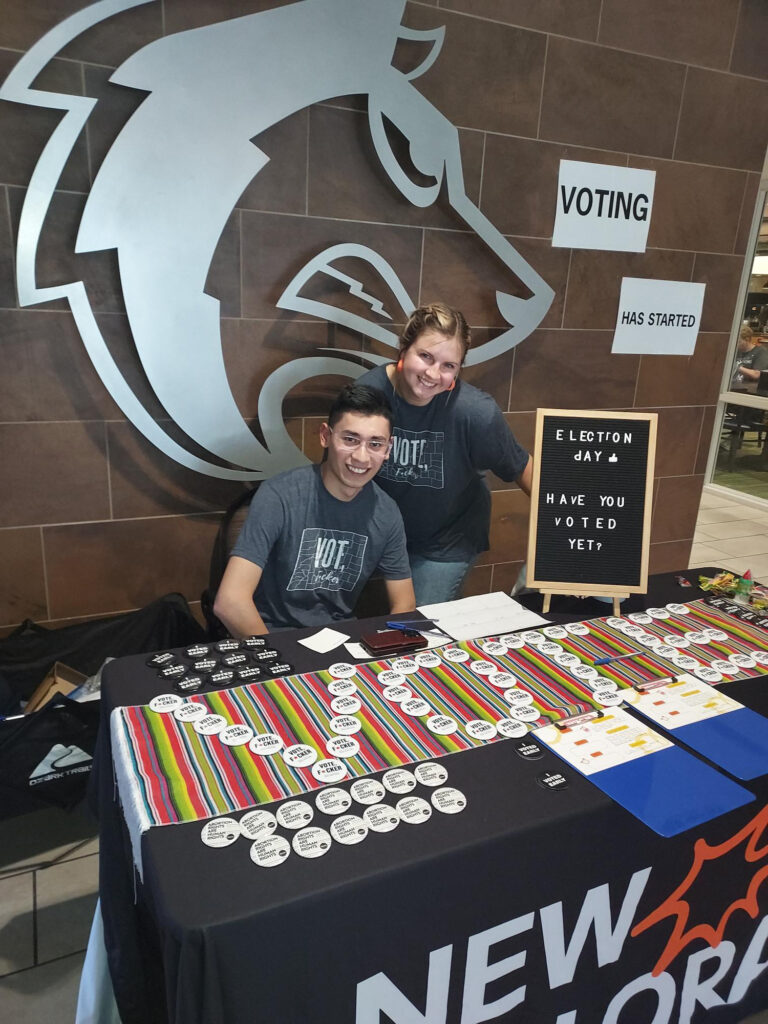
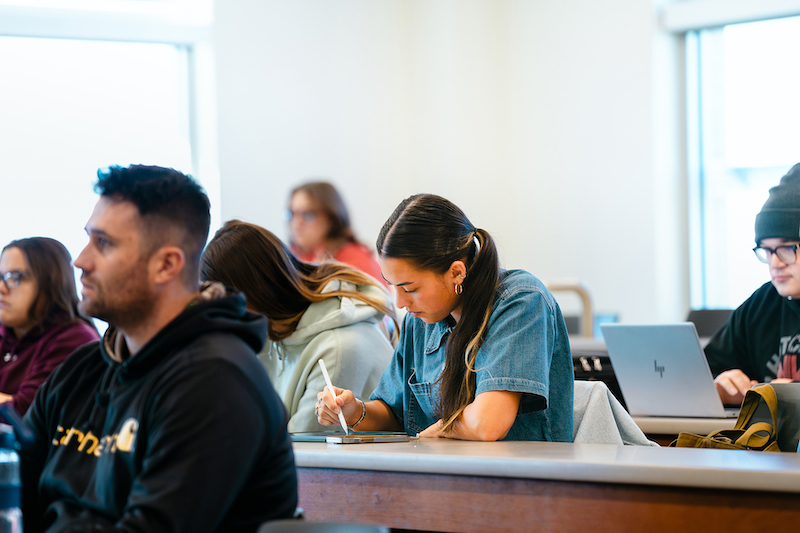
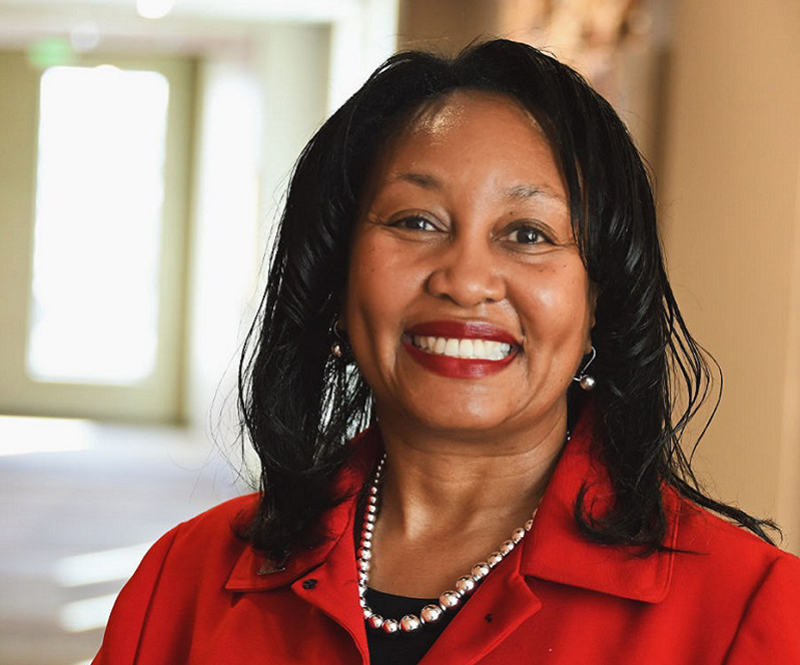
Clockwise from left: CSU Pueblo encourages students to vote as an important way to participate in democracy. / Students take a course called Media, Politics, and Power at CSU Pueblo. / Marie Humphrey, CSU Pueblo vice president for student affairs, says it’s important for universities to help develop citizens. Photography: CSU Pueblo.
From top: CSU Pueblo encourages students to vote as an important way to participate in democracy. / Students take a course called Media, Politics, and Power at CSU Pueblo. / Marie Humphrey, CSU Pueblo vice president for student affairs, says it’s important for universities to help develop citizens. Photography: CSU Pueblo.
In college, Humphrey thought she would work in health care, but then she started working in residential life on a college campus, which led to other opportunities in student affairs, to her earning a Ph.D. in educational leadership from CSU in Fort Collins, and to her coming to CSU Pueblo in 2014. “I never thought I would be doing anything in education,” she said. “But you know, when I go back and reflect on it, everything fits.”
The work of student affairs and the role of the university, she said, is about supporting and developing the “whole student – physically, mentally, emotionally, and spiritually.” That means supporting their development as citizens, encouraging them to vote, teaching them how government works, and giving them opportunities to lead.
“When you’re talking about democracy and citizenship, what we want is for them to be the best, whoever they are,” she said. Connecting, showing up, and listening are a part of that: “We cannot survive as a nation without support and care for each other, and we will not survive if we don’t provide that type of holistic support.”
Photo at top: Dana Perino is a CSU Pueblo alumna and former White House press secretary for President George W. Bush. She spoke during the university’s commencement in Spring 2023 and described her rise to the highest levels of U.S. government service. Photo: Jerod Young / CSU Pueblo.
SHARE
